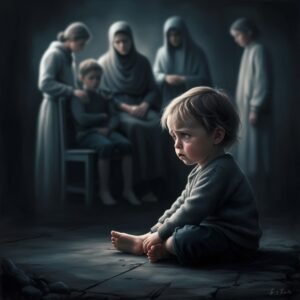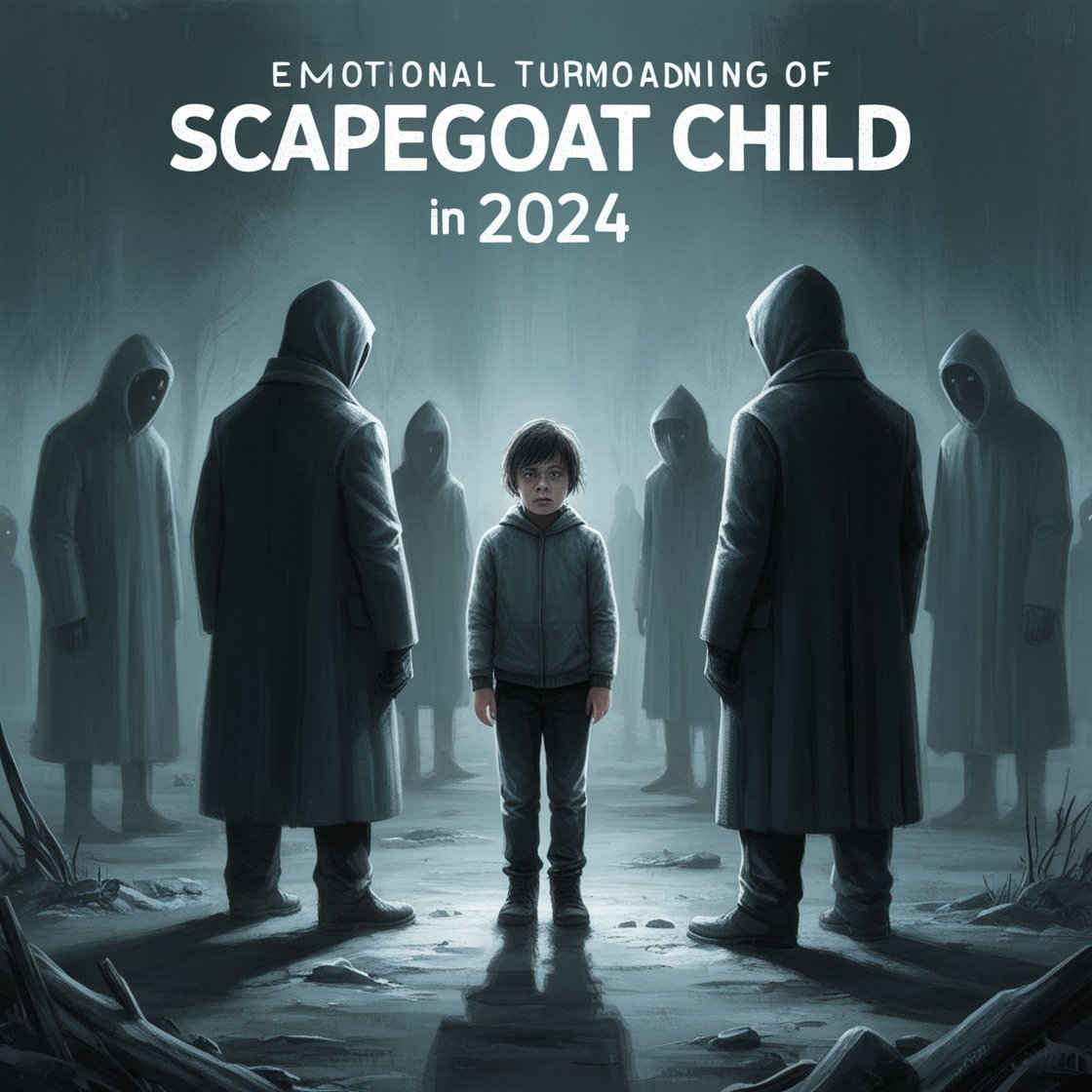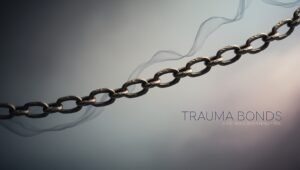The scapegoat child is a familiar figure in many families. Often misunderstood and unfairly blamed, they carry the weight of the family’s dysfunction. While the concept isn’t new, its impact continues to shape lives in profound ways. In 2024, the dynamics of family life have evolved, yet the scapegoat role persists.
Understanding the Scapegoat Role
A scapegoat child is often blamed for the family’s problems, regardless of their actual role in them. They become the lightning rod for the family’s negative emotions, while other members maintain a facade of normalcy. This dynamic can be incredibly damaging to the scapegoat’s self-esteem and mental health.
Common characteristics of a scapegoat child include:
- Blamed for everything: Any family conflict or problem is attributed to the scapegoat.
- Isolated: They feel disconnected from the family and often have few allies within it.
- Unfairly criticized: The scapegoat is constantly subjected to criticism and disapproval.
- Low self-esteem: The constant blame and isolation can lead to a negative self-image.
- People-pleasing: To avoid conflict, the scapegoat may go to great lengths to please others.
The Impact of Scapegoating
The long-term effects of being a scapegoat can be far-reaching. They may struggle with anxiety, depression, and trust issues. Relationships can be challenging, as they may fear repeating the patterns of their family of origin.
It’s important to recognize that scapegoating is a form of emotional abuse. While it may not involve physical violence, the psychological damage can be just as severe.
Breaking Free from the Scapegoat Role
Healing from the wounds of scapegoating is a journey, not a destination. Here are some steps to consider:
- Recognize the pattern: Understanding that you’re being scapegoated is the first step towards healing.
- Set boundaries: Establishing healthy boundaries with family members can help protect your emotional well-being.
- Build a support system: Connect with friends, loved ones, or a therapist who can offer support and understanding.
- Challenge negative thoughts: Develop strategies to counter the self-blame and negative self-talk.
- Focus on self-care: Prioritize your physical and mental health through activities you enjoy.
- Seek professional help: Therapy can provide valuable tools for coping with the aftermath of scapegoating.
It’s essential to remember that you are not responsible for your family’s problems. You deserve to be treated with respect and compassion. By understanding the dynamics of scapegoating, you can begin to heal and build a fulfilling life.
If you recognize yourself in this description, know that you are not alone. Many people have overcome the challenges of being a scapegoat and found happiness and fulfillment.
What is a scapegoat child
A scapegoat child is a family member, often a child, who is unfairly blamed for the family’s problems. They become the target of negative attention, criticism, and blame, serving as a scapegoat for the family’s unresolved issues.

Key characteristics of this role include:
- Unjust Blame: The scapegoat is held responsible for issues that are often beyond their control or are systemic problems within the family.
- Isolation: They often feel alone and misunderstood, as the family unites against them.
- Low Self-Esteem: Constant criticism and blame can severely damage the child’s self-worth.
- People-Pleasing: To avoid conflict or further blame, the scapegoat might develop a strong desire to please others, often at their own expense.
- Difficulty Trusting: Due to the betrayal of trust within the family, the scapegoat may struggle to form healthy relationships later in life.
The underlying dynamics of scapegoating often involve:
- Family Dysfunction: There are underlying issues within the family that are not being addressed, such as unresolved conflict, addiction, or mental health problems.
- Projection: Family members may project their own negative feelings or shortcomings onto the scapegoat.
- Distraction: By focusing on the scapegoat, the family may avoid addressing the real issues within the system.
It’s crucial to understand that being a scapegoat is not the child’s fault. The role is imposed upon them due to the family’s inability to function healthily. The long-term effects of this role can be significant, including mental health challenges and difficulties in relationships.
Childhood Trauma Self-Assessment
Note: This questionnaire is designed to help you reflect on your experiences. There are no right or wrong answers. Be honest with yourself as you respond.
Instructions: Please answer the following questions with a “Yes,” “No,” or “Sometimes.”
- Did you experience physical abuse as a child (e.g., hitting, kicking, burning, choking)?
- Did you experience emotional abuse as a child (e.g., constant criticism, rejection, gaslighting)?
- Did you experience sexual abuse as a child (e.g., unwanted touching, rape, incest)?
- Did you witness domestic violence between parents or caregivers?
- Did a parent or caregiver struggle with substance abuse or addiction?
- Did a parent or caregiver have a mental illness that significantly impacted your life?
- Did you experience neglect as a child (e.g., lack of food, shelter, or medical care)?
- Did you feel unsafe or insecure in your home environment?
- Did you have difficulty forming attachments with others?
- Do you struggle with trust issues?
- Do you often feel overwhelmed or anxious?
- Do you have difficulty regulating your emotions?
- Do you engage in self-destructive behaviors (e.g., substance abuse, eating disorders)?
- Do you experience flashbacks or nightmares related to childhood events?
- Do you avoid situations or people that remind you of your childhood?
If you answered “Yes” or “Sometimes” to several of these questions, you may have experienced childhood trauma. It’s essential to remember that everyone’s experience is unique, and these questions are just a starting point.
If you are struggling with the effects of childhood trauma, please seek professional help. A therapist can provide support, guidance, and tools to help you heal.
Additional Considerations:
- Complex Trauma: Some individuals experience multiple forms of trauma, which can have a more significant impact.
- Delayed Effects: The effects of childhood trauma may not manifest until adulthood.
- Resilience: Many people who experience trauma are able to overcome challenges and build fulfilling lives.
Remember, you are not alone. There is hope for healing and recovery.
Scapegoat and Golden Child Dynamics
In many families, a dynamic emerges where certain roles become solidified. Two prominent ones are the scapegoat and the golden child.
The Scapegoat
The scapegoat is often seen as the problem child. They are blamed for everything that goes wrong within the family, regardless of whether they are actually responsible. This constant criticism and blame can have severe emotional consequences. Scapegoats often:
- Feel isolated and misunderstood
- Develop low self-esteem
- Become people-pleasers to avoid further blame
- Struggle with trust issues
The Golden Child
In contrast, the golden child is the family’s ideal child. They are often praised and adored, creating an image of perfection. However, this role also comes with pressures:
- Constant need to maintain the perfect image
- Difficulty handling criticism
- Overdependence on parents
- Suppression of true self
It’s important to note that these roles are often complex and can shift over time. Not all families have clearly defined scapegoats and golden children, and some individuals might exhibit characteristics of both.
10 Signs of a Family Scapegoat
- Constant Blame: You are blamed for everything that goes wrong, regardless of your involvement.
- Unfair Criticism: You are subjected to constant criticism, even for minor mistakes.
- Isolation: You feel isolated and excluded from family activities or gatherings.
- Unrealistic Expectations: You are held to impossibly high standards.
- Gaslighting: Your feelings and experiences are invalidated or dismissed.
- Lack of Support: You receive little to no emotional support from family members.
- Triangulation: Family members play you against others, creating division.
- Scapegoating for Family Secrets: You are blamed for exposing family secrets or dysfunction.
- Undermining of Achievements: Your successes are downplayed or ignored.
- Feeling Different: You consistently feel like you don’t belong or fit in with your family.
Trauma Related to Development
Trauma, particularly in childhood, can significantly impact a person’s development. The effects can be far-reaching, affecting physical, emotional, cognitive, and social growth.
Impact on Development
- Physical Development: Trauma can lead to chronic health issues, sleep disturbances, and delayed physical growth.
- Emotional Development: Difficulty regulating emotions, forming attachments, and experiencing trust issues are common.
- Cognitive Development: Trauma can impact learning, memory, and attention, leading to difficulties in school.
- Social Development: Challenges in building relationships, communication, and cooperation can arise.
Types of Trauma Affecting Development
- Complex Trauma: Ongoing or repeated exposure to traumatic events, such as chronic neglect or abuse.
- Acute Trauma: A single, overwhelming event like a natural disaster or accident.
- Vicarious Trauma: Witnessing traumatic events happening to others, such as domestic violence.
Long-Term Effects
The effects of trauma can persist into adulthood, manifesting as:
- Mental health issues like depression, anxiety, or PTSD
- Substance abuse
- Difficulty maintaining relationships
- Occupational challenges
Resilience and Recovery
While the impact of trauma can be profound, it’s essential to remember that resilience is possible. With appropriate support and intervention, individuals can heal and thrive.











